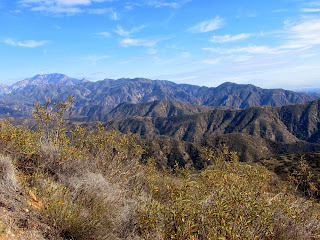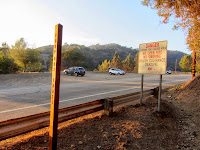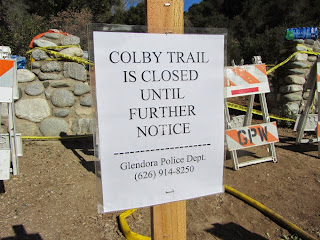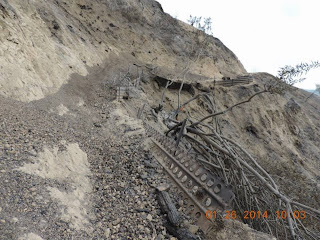The devastating Colby Fire that consumed nearly 2,000 acres of our beautiful mountainside above Glendora and Azusa last week has been occupying my mind. I felt compelled to hit the trail today to achieve a vantage point to survey the east end of the burn zone where it started. Mystic Canyon Trail and beyond is ideal for such a hike.
My wife drives me to the trailhead since it is close to home and she needs the car today. We turn onto Glendora Mountain Road and a lighted sign reads, “Hiking Trails Closed.” I don’t suspect that that applies to where I’m heading, and it didn’t. We turn right onto Big Dalton Canyon Road and drive the half mile to the trailhead. There are ten vehicles parked here. It’s brisk.
9:00 AM – Begin hike on Upper Mystical Canyon Trail. Within a couple minutes the trail gets crazy steep. I had forgotten how steep it is. But the steepness doesn’t last long and soon I’m out of the shade and views open up to the southwest beyond. A group of about 12 young folks and several adults pass by heading down. I’m enjoying the rich chaparral…such a contrast to my burned mountain in Azusa. It almost feels like summer with so many of the plants being parched from our drought conditions.
I slip and fall and get a nasty scrape on my wrist. Thankful for coagulation. Summit 2760 comes into view at the head of canyon. I snap pics of wild cucumber and purple nightshade flowers, the only thing I’ve seen in bloom so far. Tiny leaves of poison oak emerge from dormant sticks. At the saddle, I turn left (west) take the short spur trail to Poop-Out Trail that runs along the ridge. I get my first good views west across Little Dalton Canyon toward the burn area. What’s encouraging is mountainsides covered with mature chaparral untouched by the fire. I turn north for the steep climb.
9:43 – Lower Monroe Road. Looking north toward Glendora Mountain, I get a good view of the freshly cut dozer lines. I chat with a mountain biker. There are other trail users but it doesn’t feel crowed. The warm sun feels good. I head northeast on the old truck trail, which points directly to Summit 2760. Within a minute I veer right and transition to the ridgeline which parallels the old road, just to follow a narrow path. Views are expansive over the rugged chaparral-covered mountains. Two lone blossoms of California buckwheat bask in the sun. What’s absent is the green grass that would normally present this time of year.
Soon the route rejoins the main trail and I come to a post marked “Punk Out.” The post also says Dalton IHC. I have no idea what that means but later a Google search reveals that it probably refers Dalton Integrated Hotshot Crew. I veer right unto Punk Out Trail to continue my saunter long the undulating ridge. It’s steep in spots, providing an opportunity to catch my breath while enjoying the sweeping panorama.
When I arrive at the base of the steep section going straight up the south ridge of Summit 2760, I sit for a break and treat my abrasion. At 10:40 I begin my climb. I’ve come down this route before but I think this is my first time to climb it. It’s crazy steep and certainly not for the faint-of-heart. Soon I see a young man coming up the trail behind me. His pace is faster and he passes me. I continue up, carefully choosing the spot for each step and stopping occasionally to catch my breath. I’m encouraged when I see bicyclists cross on the trail not far above.
11:02 - Reach Lower Monroe Road again near Summit 2760. What a climb! I chat with the young man, whose name is Clayton. He is student at the Rio Hondo College studying to be a wildland firefighter. We say goodbye and I continue north up the road at 11:27. In a couple minutes I reach the saddle then double back for the finial climb.
11:33 - Summit 2760. This is really a splendid peak. It should have name. I post a pic to FB. Due west across Little Dalton Canyon is Summit 2583, where I was on December 31 before descending Upper Colby Trail. A newly cut dozer line replaced the path I walked up to the summit from Glendora Ridge Road. A helicopter lands on the summit. I suspect it has some function related to the fire.
From this perspective I see only a small portion of the burn area. In contrast, I am surrounded by many thousands of areas of mature chaparral. I’m encouraged because I know that most of this area was incinerated by the 2002 Williams Fire, which burned 37,240 acres. Now it’s thriving nicely. A prime motive for today’s hike was to view Colby Fire damage. What I did not anticipate was the therapeutic value of being surrounded by miles of rich, mature wildlands. It is so peaceful and rejuvenating here.
When I started today, I did not know how far I’d hike, thinking maybe I’d turn around at this point. But now that I’m here, I think I’ll continue on to Summit 3397, which stands north north east and calls me higher.
I leave the summit at 11:55 and in three minutes I’m back on the road. I’m enjoying the scenery and solitude. Three mountain bikers swoosh by. One of the downsides of this trail is that are many segments where the trail tread has been worn into a rounded trench by the bike traffic. It makes it uncomfortable to walk.
Although there is virtually nothing in bloom, some occurrences of ceanothus, purple nightshade, Spanish broom, and current add a few tiny dots of color amidst a vast sea of gray and varied muted greens. Some views open up east toward Mt. Baldy and Ontario Ridge. It’s odd to see them without snow in January. I think about some friends who are hiking there today. As I get closer to the broad ridge dropping south from Summit 3397, I think about my adventure bushwhacking down that route a few years back. Today I don’t see any sign of a clear route. I stay on the trail. As the route bends around the west hip, views toward the north open up. Traffic on GMR puzzles me because it’s supposed to be closed today. Scattered high clouds add interest to blue sky. I arrive at the junction north of the summit at 12:49 and am treated to a striking panorama of the eastern high country. I turn right (south), pass straight through the old beehive area, and begin the gentle climb up the old firebreak. A lupine stands tall with it first purple bloom of the season.
12:59 - Summit 3397. The large, flat summit is the highest point in this section of the range. I’m surprised that it’s not named. It offers commanding views except toward the northwest, which is obscured by vegetation. I sit in a clear spot on the southwest edge, post a pic to FB, and soak in the beauty. Far below me I see my trail. Summit 2960 looks tiny from here. Beyond the mountains to the south, the vast human sprawl disappears into haze. I look over the expansive San Dimas Experimental Forest which covers 32-square miles to the south and east of where I sit. I ponder its peaks, ridges, canyons, and waterfalls…most never or rarely visited by humans and off limits to the public. Which begs the question, how would I know that I can’t just leave this summit and descend into the forbidden furrows below? There are no signs anywhere en route. Of course if I was arrested for trespassing and pleaded ignorance, they would take one look at my website and quickly realize that I’m far for ignorant. So I guess I’ll be a good boy and stay out, at least today.
I leave the summit at 1:30 and begin to retrace my steps. When I arrive at the road, I wander north for a few minutes to get some different views. Back at the junction I continue my homeward trek. I’m always amazed that I can hike in such a splendid local and have it virtually to myself. Where are all those hundreds of Garcia Trail hikers now that it’s closed?
I pass by the Punk Out junction near Summit 2760 at 2:25, choosing to walk back via Upper Monroe Road rather than down Punk Out…it’s just too steep for downhill, at least today. I enjoy the zig-route down the west-facing slope. A sticky monkey flower is in bloom. A couple mountain bikers pass. Stop and chat with three hikers; one is Tommy, who I met on Garcia Trail a couple years ago. I pass the spur trail that connects to the bottom end of the Punk Out steep section at 3:15. I pass the Punk Out post at 3:25. I’m aware that a good section of this return route is new track for me today since I walked along the ridgeline earlier.
At 3:35 I reach the Upper Mystic Canyon Trail junction. I chat with a gal who just hiked up. I head down Mystic (new section for me today) then at the saddle I transition unto Poop-Out Trail for my descent, just to keep mixing things up. And I figure since I’m being picked up, I’d save the half-mile walk between trail heads.
The first part of Poop-Out is mild. Then there are a couple steeper sections which require some careful steps. Then I reach the nightmare. The route is absurdly steep with precarious footing. It’s just crazy! Note to self: Never descend this way again! I cautiously pick my down, sometimes with all fours and on my butt, and sometimes backwards. About halfway down I put on my leather gloves for protection. I’m not having fun. I reach the landing at the switchback and can see my wife parked below. The route gets sane. I make it safely to the bottom in one piece with no falls or injuries. Thankful!
4:35 - End hike.
Epilog - A most rewarding day! I covered about 8.5 miles with 2,300 feet in elevation gain. That’s a good workout. I loved the solitude and serenity yet enjoyed some interaction with others. The weather was amazing and the snowless backcountry in January was strange. I was able to view some of the Colby Fire areas but was rejuvenated being surrounded by miles of mature plant life.
See Mystic Canyon Trail & Lower Monroe Road to Summit 2760 and Summit 3397 Hike Description on Dan’s Hiking Pages
See Colby Fire - January 16, 2014 blog post






































